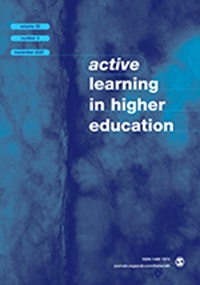询问学生与大学的契合度:需求能力契合度的响应面分析
IF 3.8
1区 教育学
Q1 EDUCATION & EDUCATIONAL RESEARCH
引用次数: 1
摘要
学生的感知适合度是高等教育学习成功的最突出预测因素之一,但当直接评估时,它为受访者提供了很大的解释空间。感知需求-能力匹配也是如此(例如,一个人的能力如何与学习需求相匹配),这与学习成功有着特别高的关联。因此,我们调查了(1)当被问及他们感知的需求-能力适合时,学生如何将需求和能力结合起来;(2)当被以不具体的方式问及他们对适合的感知时,他们心中有哪些需求和能力。我们获得了关于N的感知拟合的数据 = 来自四个德语国家的595名大学生,并使用响应面分析对他们进行了分析。结果表明:(1)当感知需求和感知能力分别测量时,感知需求-能力拟合并不对应于感知需求和认知能力的一致性,而是反映了能力的强线性效应。此外,他们还表明:(2)特定的需求和能力不会影响需求和能力组合为适合分数的方式,但在特定需求和能力之间解释的差异量存在差异。研究结果对先前的发现提出了新的解释,并挑战了当代对感知适合的理解。例如,感知的适合度和自我效能感可能比以前假设的更紧密地联系在一起。因此,在努力提高感知适合度时,从业者应专注于培养个人能力和感知能力。本文章由计算机程序翻译,如有差异,请以英文原文为准。
Asking students about their fit with the university: A response surface analysis of demands-abilities fit
Perceived fit of students is one of the most prominent predictors of study success in higher education, but when assessed directly, it provides lots of room for interpretation for the respondents. This is also true for perceived demands-abilities fit (e.g. how do one’s abilities fit with study demands), which has particularly high associations with study success. We, therefore, investigated (1) how students combine demands and abilities when asked about their perceived demands-abilities fit and (2) which demands and abilities they have in mind when asked about their perceptions of fit in an unspecific manner. We obtained data on the perceived fit of N = 595 university students from four German-speaking countries and analyzed them using response surface analysis. The results indicate that (1) perceived demands-abilities fit does not correspond to the congruence of perceived demands and perceived abilities when the latter two are measured separately, but rather reflects a strong linear effect of the abilities. Furthermore, they show that (2) the specific demands and abilities do not influence the way how demands and abilities are combined to a fit score, but that there are differences in the amount of explained variance between the specific demands and abilities. The results speak for a new interpretation of prior findings and challenge the contemporary understanding of perceived fit. For example, perceived fit and self-efficacy might be more closely associated than previously assumed. When striving to enhance perceived fit, practitioners should thus focus on fostering individual abilities and their perceptions.
求助全文
通过发布文献求助,成功后即可免费获取论文全文。
去求助
来源期刊

Active Learning in Higher Education
EDUCATION & EDUCATIONAL RESEARCH-
CiteScore
13.20
自引率
12.00%
发文量
31
期刊介绍:
Active Learning in Higher Education is an international, refereed publication for all those who teach and support learning in higher education (HE) and those who undertake or use research into effective learning, teaching and assessment in universities and colleges. The journal is devoted to publishing accounts of research covering all aspects of learning and teaching concerning adults in higher education. Non-discipline specific and non-context/country specific in nature, it comprises accounts of research across all areas of the curriculum; accounts which are relevant to faculty and others involved in learning and teaching in all disciplines, in all countries.
 求助内容:
求助内容: 应助结果提醒方式:
应助结果提醒方式:


